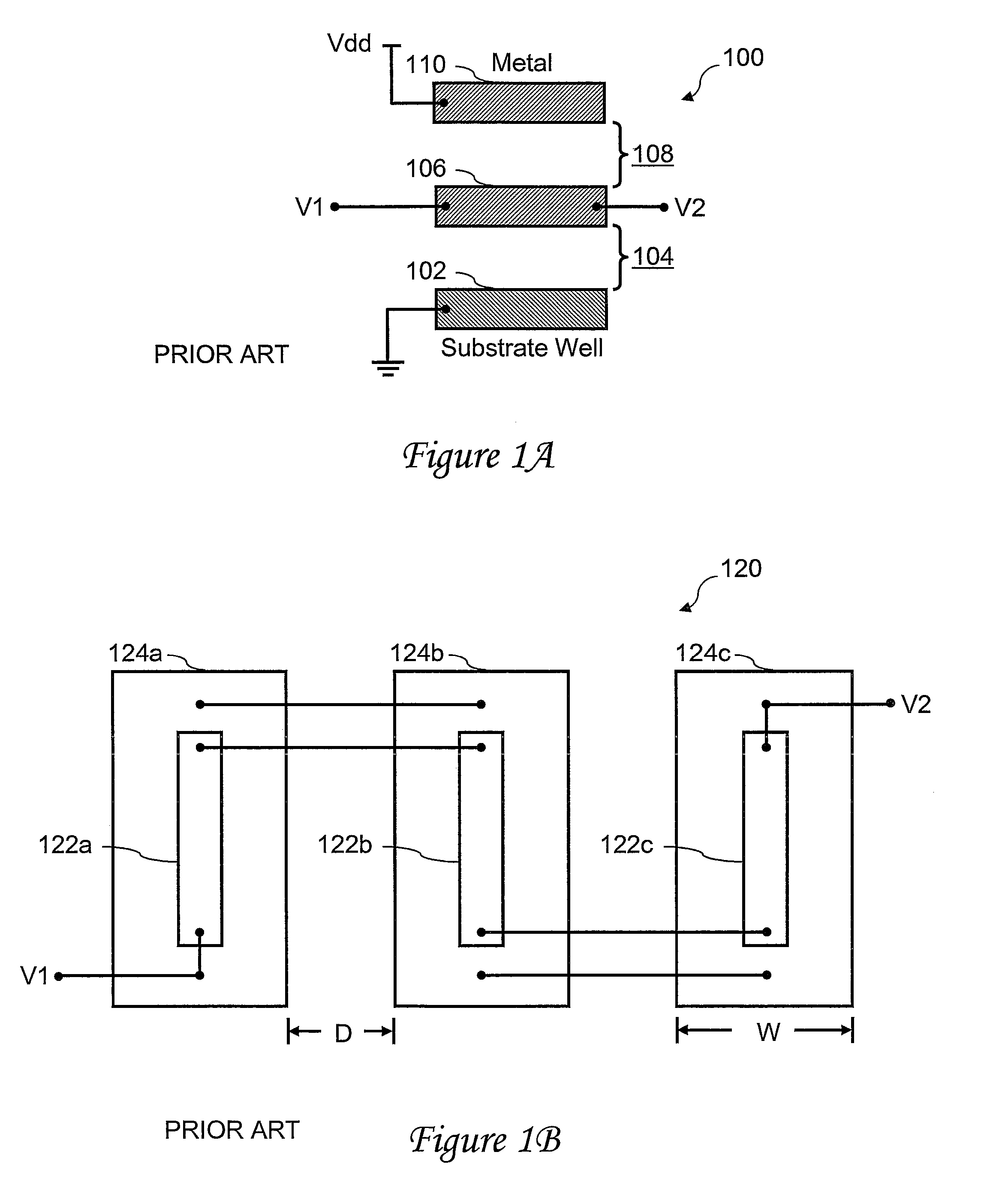Compensation of field effect on polycrystalline resistors
a polycrystalline resistor and field effect technology, applied in the field of electric circuitry, can solve the problems of metallization layer, inefficient use of bootstrapped resistors in die area (and therefore cost), and difficulty in overlaying each polycrystalline resistor
- Summary
- Abstract
- Description
- Claims
- Application Information
AI Technical Summary
Benefits of technology
Problems solved by technology
Method used
Image
Examples
first embodiment
[0035]Referring now to FIG. 3A, there is illustrated a section view of a resistive circuit 300 in accordance with the present invention. As depicted, resistive circuit 300 includes a first terminal 302a characterized by voltage V1 and a second terminal 302b characterized by voltage V2, where voltage V2>voltage V1. Coupled between terminals 302a, 302b are multiple (in this case, two) resistive segments 304a, 304b formed of polycrystalline silicon or other resistive material subject to non-linear behavior when subjected to an electric field. Resistive segments 304 are spaced apart from one another and electrically coupled to each other, in this case in series, by a conductor 306, such as a metal.
[0036]Resistive circuit 300 further includes multiple third terminals 308a, 308b equal in number to the number of resistive segments 304. Each third terminal 308 is coupled at one end to an end of a respective resistive segment 304, in this case at one of first and second terminals 302a, 302b....
second embodiment
[0039]FIG. 3B depicts a resistive circuit 314 in accordance with the present invention. The embodiment of FIG. 3B is identical to that of FIG. 3A, except that the embodiment of FIG. 3B includes multiple third terminals for each resistive segment 304. That is, third terminals 308a1 and 308a2 apply positive electric fields 312a1 and 312a2 to resistive segment 304a, and third terminals 308b1 and 308b2 apply negative electric fields 312b1 and 312b2 to resistive segment 304b. It will be appreciated that not all third terminals for a resistive circuit are required to be formed of the same material. For example, in some implementations, third terminals 308a1 and 308b1 are implemented as substrate wells, and some third terminals 308a2 and 308b2 are implemented with metallizations.
third embodiment
[0040]FIG. 3C illustrates a resistive circuit 316 in accordance with the present invention. The embodiment of FIG. 3C is similar to that of FIG. 3A, except that third terminals 308a, 308b are directly connected to one another and are each electrically connected to the ends of resistive segments 304a, 304b distal from terminal 302a, 302b. As a result of this connection, third terminal 308a applies a negative electric field to resistive segment 304a, and third terminal 308b applies a positive electric field to resistive segment 304b.
[0041]FIG. 3D illustrates a fourth embodiment of a resistive circuit 320 in accordance with the present invention. The fourth embodiment of FIG. 3D employs a central connection of the segmented third terminal to the resistive segments similarly to the embodiment of FIG. 3C, but includes multiple third terminals for each resistive segment 304 as described above with reference to FIG. 3B. As depicted, third terminals 308a1 and 308a2 apply negative electric ...
PUM
 Login to View More
Login to View More Abstract
Description
Claims
Application Information
 Login to View More
Login to View More - R&D
- Intellectual Property
- Life Sciences
- Materials
- Tech Scout
- Unparalleled Data Quality
- Higher Quality Content
- 60% Fewer Hallucinations
Browse by: Latest US Patents, China's latest patents, Technical Efficacy Thesaurus, Application Domain, Technology Topic, Popular Technical Reports.
© 2025 PatSnap. All rights reserved.Legal|Privacy policy|Modern Slavery Act Transparency Statement|Sitemap|About US| Contact US: help@patsnap.com



